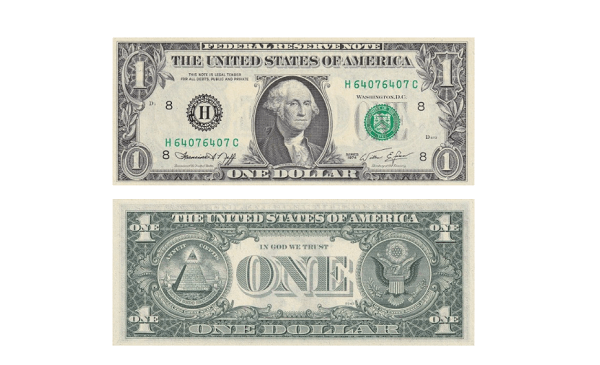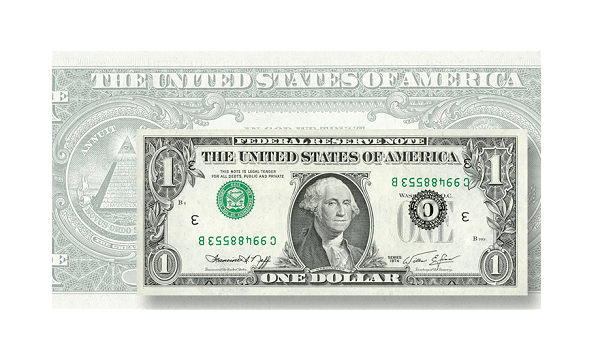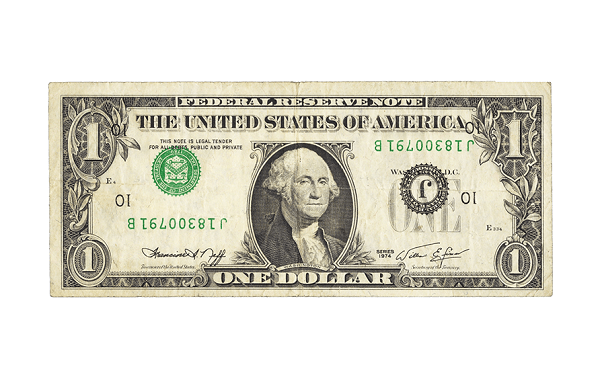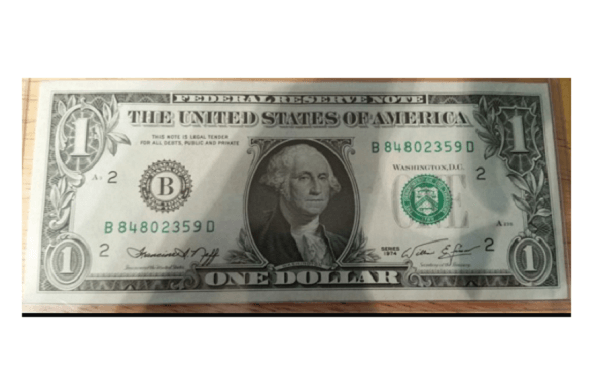1974 1 Dollar Bill Value – The 1974 one dollar bill, most people assume it’s just another common note with little to no value. However, within this seemingly ordinary currency lies an intriguing tale of unexpected errors that transformed some of these bills into coveted collectibles worth more than their face value.
The Bureau of Engraving and Printing (BEP) in 1974 found itself amidst experiments involving note inspection equipment during the production of these bills.
E.J. Prescott, the BEP’s assistant director for operations at the time, mentioned that these errors resulted from changes in procedures during experimentation with their Currency Overprinting Processing Equipment.
The errors stemmed predominantly from human oversight during a crucial phase of the printing process. An alteration in the inspection method, where notes were mechanically moved instead of manually examined, played a pivotal role in the emergence of these errors.

One of the most notable errors was the inverted overprint, occurring when half-sheets were inserted in the overprinting equipment in the wrong orientation.
This resulted in a complete inversion of all overprinting elements from their intended positions.
Surprisingly, BEP officials were unaware of these issues until the error notes entered circulation. It was then realized that this was not an isolated incident but rather a sequence of production problems occurring repeatedly.
The production of these bills involved an intricate process. They were printed using the intaglio printing method, where engraved plates created raised designs on the paper.
The bills were printed in two stages, allowing each ink color to dry for 48 hours between passes through the printing press.
However, the twist in the tale happened during the final printing phase. Half-sheets were inadvertently inverted, and these error-prone sheets slipped into circulation unnoticed.
Collectors and enthusiasts later stumbled upon these rare notes, leading to a flurry of discoveries across different Federal Reserve Districts.
One such discovery was made by Forman, a dealer in Philadelphia, who found a sequential run of 30 inverted overprint error notes. Similar instances followed in different districts, with collectors uncovering these rare bills from bricks of 4,000 notes.
The rarity and uniqueness of these errors captured the attention of collectors, with some of these notes fetching significant prices in auctions.
For instance, a Gem Crisp Uncirculated note from Forman’s discovery sold for $488.75 in an auction held in January 2007.
Instances of inverted overprint errors bearing various Federal Reserve District seals surfaced across different states, each adding to the mystique surrounding these bills.
Their scarcity and unexpected nature have made them prized possessions among collectors, often becoming sought-after items in the world of numismatics.
Even today, these 1974 one dollar bills with inverted overprints continue to hold fascination for collectors, showcasing the allure of rare and unexpected finds within the world of currency.
The story of the 1974 $1 dollar bill serves as a testament to the unpredictability that can sometimes turn an ordinary currency note into a valuable and cherished artifact.
1974 1 Dollar Bill Specifications
The 1974 $1 Federal Reserve Note, representing a denomination of one dollar in United States currency, is classified as a Federal Reserve Note.
These notes bear the signatures of officials involved in their issuance, with signature varieties identified as Neff and Simon for the Series 1974.

- Denomination: $1.00 USD
- Type: Federal Reserve Note
- Signature Varieties: Neff and Simon
- Series: 1974
The Series 1974 notes were part of the ongoing evolution of the United States currency and were marked by distinct features and designs typical of their era.
These notes, despite being a common denomination in everyday transactions, possess a unique historical significance owing to certain error variants that have gained attention among collectors and enthusiasts.
1974 1 Dollar Bill Value and Star Notes
In general, most 1974 $1 bills in circulated condition hold a face value of $1. However, those in uncirculated condition, especially star notes, hold additional value.

Star notes, replacement bills denoted by a star symbol at the end of the serial number, are rarer and thus more valuable.
Uncirculated 1974 $1 bills typically fetch around $4.50, reaching higher prices of $10-15 for those graded MS 63.
Star notes from the Cleveland and Minneapolis Federal Reserve Banks tend to command higher prices due to their scarcity and collector demand.
Uncovering The Errors: Series 1974 Dollar Bills
When the 1974 $1 bills were in production, the Bureau of Engraving and Printing (BEP) experimented with note inspection equipment. These experiments inadvertently led to errors in the printing process. E.J. Prescott, the BEP’s assistant director for operations at the time, attributed these errors primarily to human mistakes resulting from changes in the inspection procedure.

The notable ‘inverted overprint error’ occurred due to half sheets being turned in the wrong direction before insertion into the printing equipment, causing all overprinted elements to be inverted from their standard positioning.
This deviation from the usual process played a pivotal role in creating these errors.
BEP officials initially remained unaware of these errors until they entered circulation. It became evident that these printing issues were not isolated incidents but part of a recurring sequence of production problems.
The Printing Process and Error Origin
The 1974 series notes underwent a meticulous printing process involving intaglio printing, wherein engraved plates were used to incuse and reverse the lettering and design elements. The ink was rolled onto these plates, creating a raised printed effect.
During the initial printing pass, the back of the notes received a single color of ink, followed by the addition of primary face elements during the second pass in another color.
The final stage involved the use of Currency Overprinting Processing Equipment (COPE), where errors occurred due to the inversion of half sheets.
These error notes slipped into circulation, causing a stir among collectors and dealers, with sequential runs of 30 notes bearing the inverted overprint error being discovered in 4,000-note bricks.
Conclusion
The 1974 $1 dollar bill stands as an iconic piece of U.S. currency, often circulated widely and retained for its historical significance. However, amidst the ordinary circulation, a fascinating series of printing errors emerged, leading to some of these bills becoming highly sought after by collectors.
The 1974 $1 dollar bill, once an ordinary piece of currency, gained prominence due to printing errors that inadvertently turned it into a collector’s item.
Despite most bills holding their face value in circulation, the discovery of these error notes, particularly the inverted overprint variations, has fascinated collectors and enthusiasts alike, elevating their worth and adding a captivating story to these humble dollar bills.
You chance upon a regular 1974 $1 bill or stumble upon a rare inverted overprint error note, the journey through the history and value of these bills showcases the intriguing world of currency collecting and the unexpected allure of a seemingly ordinary dollar.